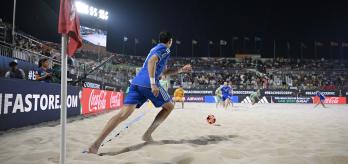The frequency with which “narrow” wingers made inverted runs from deep positions within the 1-2-2 formation caught the highly-trained eyes of Matteo Marrucci and Dejan Stankovic. Wingers in this formation traditionally played very wide, close to the edge of the court. However, a number of teams at this World Cup asked their wingers to play more narrowly, and used inverted, central runs from their wide defenders to create goal-scoring opportunities.
Examples of inverted runs
In the clips below, we see examples of these inverted runs from Iran, Brazil, Colombia and Spain, highlighting how several teams put their own spin on the same basic idea during the tournament in Dubai. Former Italy defender Matteo Marrucci saw this development as a clear evolution in teams’ approaches to build-up play in the classic 1-2-2 formation:
“This is new and very deliberate”, he said. “It is clear teams have really worked on this prior to the tournament. We saw it a couple of times in Russia in 2021, but this time it was much more structured, and the patterns were more clearly constructed. The narrow wingers open the space in the wide channels, but the runners from deep go central using diagonal runs. We see this very clearly in clip 1 below, when Iran do it against Brazil.
“We see how Ali Mirshekari (7) starts high and narrow in the 1-2-2 before rotating with Mohammad Masoumi (11). When Mirshekari plays back to his goalkeeper, we clearly see the 1-2-2 structure again as he immediately makes the diagonal run into the central space. When he receives the ball from the opposite, low-lying, wide player, he has time to execute a bicycle kick attempt at goal.”
This principle of attacking play was used by a number of other teams throughout the tournament, and all of them added nuances of their own in the way they constructed their attacks. These unexpected inverted runs disrupted opposition defensive structures and gave defenders difficult decisions to make.
The members of our TSG have picked out a series of examples from the tournament, which you can see in the clips below. The variety of different approaches impressed Switzerland international Dejan Stankovic:
“Teams were getting more success with these patterns, so it was very interesting to see the different approaches,” he said. “For example, in clip 2 below, we see how Brazil do it, with Filipe (5) on the left being the main protagonist. The space is created by the positions of his other three outfield players, locking in defenders. Brazil start in the 1-2-2 formation with narrow wingers, before Filipe drops deep to receive the ball. Before he plays back to his goalkeeper, Bobo (12), he clearly looks forward to see if the space he wants is available. As soon as he makes the diagonal run inside, his marker, Enoch López (8), has a decision to make. Does he go with Filipe or press Bobo? He decides to do the latter, leaving Filipe free in space and with time to attempt a bicycle kick, which is blocked. The defender who blocked the bicycle kick attempt also had to choose between advancing to make the block and leaving the forward he was marking. It's a clever but pre-conceived pattern of offensive play that leads to defenders having decisions to make.”
In clip 3, we see a similar diagonal run from Colombia defender Wilmar Donado (3). On this occasion, Japan’s deepest defenders split up: one opts to leave the player he is marking to press Wilmar in the space in front of him, while his defensive partner takes up a central position. If either Colombia winger receives the ball, he will press that player.
In clip 4 we see another example of defensive rotation, this time by Argentina as they try to deal with the diagonal run from Iran’s Reza Amiri (3). In the final clip, we see how Spain’s narrow winger pulls wide as team-mate Antonio (10) receives the ball, thus creating space inside for him to make the diagonal run.
SUMMARY
At this tournament, the Technical Study Group noticed a significant change in the way teams used narrow wingers and wide defenders to exploit space when attacking in a 1-2-2 formation. Traditionally, wide wingers would penetrate the space in the wide area. However, during FIFA Beach Soccer World Cup UAE 2024™, wingers stayed narrow and the central space in front of them was targeted in pre-planned, deliberate attacking movements by wide defenders.
These diagonal runs caused disruption to the defensive rhythms and structures of the defending teams, forcing defenders to make difficult decisions, either to leave the player they were designated to mark or to press the extra attacker creating a dangerous overload.



















